22.01.2025
Shenzhou-19 crew completes second series of extravehicular activities
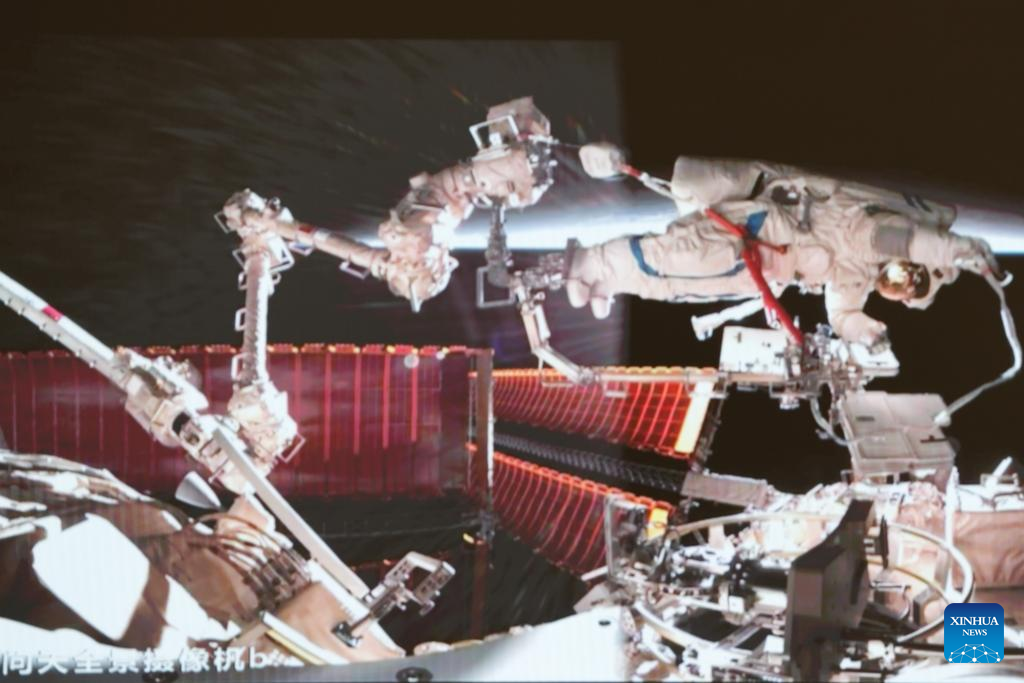
This screen image captured at Beijing Aerospace Control Center on Jan. 20, 2025 shows Shenzhou-19 astronaut Song Lingdong performing extravehicular activities outside China's orbiting space station. (Xinhua/Liu Fang)
Members of the Shenzhou-19 crew aboard China's orbiting space station completed their mission's second series of extravehicular activities (EVAs) at 1:12 a.m. (Beijing Time) on Tuesday, according to the China Manned Space Agency.
Astronauts Cai Xuzhe, Song Lingdong and Wang Haoze worked for 8.5 hours to complete multiple tasks, including the installation of space debris protection devices and an extravehicular inspection. They were assisted by the space station's robotic arm and a team on Earth.
Cai and Song, the two crew members assigned to undertake spacewalk duties, have since returned to the Wentian lab module safely.
Since completing their first spacewalk on Dec. 17, 2024, the crew members have undertaken a series of tasks, including the inspection and maintenance of the space station's equipment, system-wide pressure emergency drills, and preparations for the second series of EVAs.
They have completed nearly half of their space journey and are scheduled to carry out a significant number of in-orbit scientific experiments and technological tests, the agency said. Amid their busy schedule, they will also welcome the upcoming Spring Festival, also known as the Chinese Lunar New Year. ■

This screen image captured at Beijing Aerospace Control Center on Jan. 20, 2025 shows Shenzhou-19 astronaut Cai Xuzhe working inside the airlock cabin of China's orbiting space station. (Xinhua/Liu Fang)

This screen image captured at Beijing Aerospace Control Center on Jan. 20, 2025 shows Shenzhou-19 astronaut Wang Haoze working inside China's orbiting space station. (Xinhua/Liu Fang)

This screen image captured at Beijing Aerospace Control Center on Jan. 20, 2025 shows Shenzhou-19 astronaut Song Lingdong leaving China's orbiting space station for extravehicular activities. (Xinhua/Liu Fang)

This screen image captured at Beijing Aerospace Control Center on Jan. 20, 2025 shows Shenzhou-19 astronaut Song Lingdong performing extravehicular activities outside China's orbiting space station. (Xinhua/Liu Fang)

This screen image captured at Beijing Aerospace Control Center on Jan. 20, 2025 shows Shenzhou-19 astronauts Cai Xuzhe (R) and Song Lingdong (L) performing extravehicular activities outside China's orbiting space station. (Xinhua/Liu Fang)
Quelle: Xinhua
----
Update: 27.02.2025
.
China Focus: Shenzhou-19 crew successfully tests pipeline inspection robot on space station

China's Shenzhou-19 crew aboard the orbiting Tiangong space station recently completed the in-orbit test of a pipeline inspection robot, laying a solid technical foundation for future pipeline inspections on the space station.
The astronauts constructed a simulated pipeline in orbit, which included straight pipes, curved pipes and conical pipes of various diameters. Within this simulated pipeline, they conducted tests on the robot's mobility, its extraction from its contracted state and its extraction after fine-tuning its status, according to the China Manned Space Agency (CMSA).
During the test, the robot demonstrated stable and reliable movement through various types of pipelines, validating its autonomous mobility technology designed to suit multiple complex pipeline structures. Additionally, the robot could be easily extracted from complex pipelines even after a power outage, confirming the safety of its passive compliant mechanism.
As the first in-orbit test of a special-purpose robot conducted on China's space station, it showcased the robot's autonomous adaptability and safety in complex pipeline environments, accumulating valuable experience for future practical applications of robots in space station pipelines, the CMSA said.
The CMSA noted that a pipeline inspection robot faces numerous challenges within pipelines. For instance, it must adapt to the complex structures inside the space station's pipelines and complete autonomous movements.
It also needs to ensure its own safety -- including maintaining appropriate contact force with pipeline walls, adapting to changes in pipeline diameter and avoiding becoming stuck in the pipeline in unexpected situations.
To overcome these challenges, researchers developed a biomimetic variable stiffness design for this pipeline inspection robot.
Inspired by the tube feet of echinoderms such as starfish, sea urchins and sea cucumbers, which retract into the body when at rest and extend outward during movement, the researchers designed a combined active and passive leg-scissor mechanism for the robot.
The passive mechanism enables the robot's legs to swiftly adjust their length in response to changes in pipe diameter, ensuring adaptability to varying pipe sizes.
Meanwhile, the active mechanism dynamically regulates the pressure between the robot's feet and the pipe wall, guaranteeing reliable contact and providing sufficient propulsion for the robot to move forward.
The robot's intelligent "brain" calculates its posture and position using its full-body sensors and generates a motion strategy. Under the premise of ensuring pipeline safety, it adjusts the positions, speeds and force outputs of all joints to enable smooth movement within the space station's pipelines.
During the test, ground personnel monitored the robot's position, current, contact force and other status data in real-time through ground support software, synchronously observing the robot's movement. This allowed them to assist astronauts in completing in-orbit operations.
Also, by analyzing the acquired data, ground personnel assessed the test results, providing a basis for subsequent experiments.
Quelle: Xinhua
----
Update: 22.03.2025
.
Shenzhou-19 crew completes third extravehicular activities
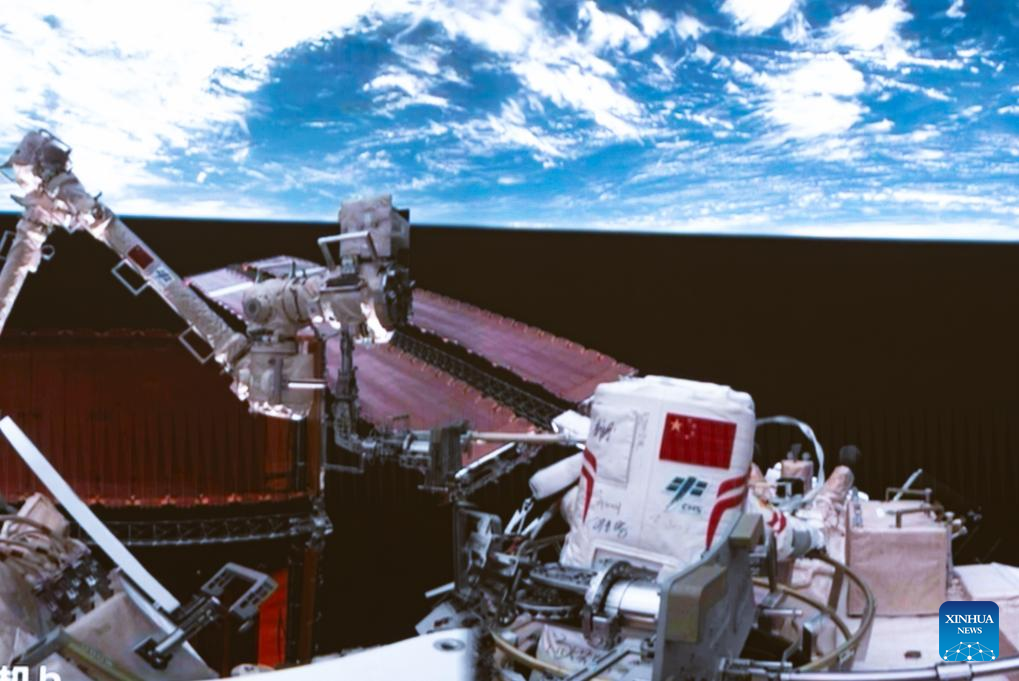
This screen image captured at Beijing Aerospace Control Center on March 21, 2025 shows Shenzhou-19 astronaut Cai Xuzhe leaving China's orbiting space station for extravehicular activities. (Xinhua/Li Minggang)
Members of the Shenzhou-19 crew aboard China's orbiting space station completed their mission's third series of extravehicular activities (EVAs) at 8:50 p.m. (Beijing Time) on Friday, according to the China Manned Space Agency (CMSA).
Astronauts Cai Xuzhe, Song Lingdong and Wang Haoze worked for about seven hours to complete multiple tasks, including the installation of space debris protection devices and extravehicular auxiliary facilities, as well as extravehicular equipment inspection. They were assisted by the space station's robotic arm and a team on Earth.
Cai and Song, the two crew members assigned to undertake spacewalk duties, have since returned to the Wentian lab module safely. Cai has now carried out five extravehicular missions, more than any other Chinese astronaut to date, according to the CMSA.
The Shenzhou-19 crew has been in space for nearly five months, and the various space scientific experiments and tests are progressing smoothly. The crew is scheduled to return to Earth in more than a month. ■
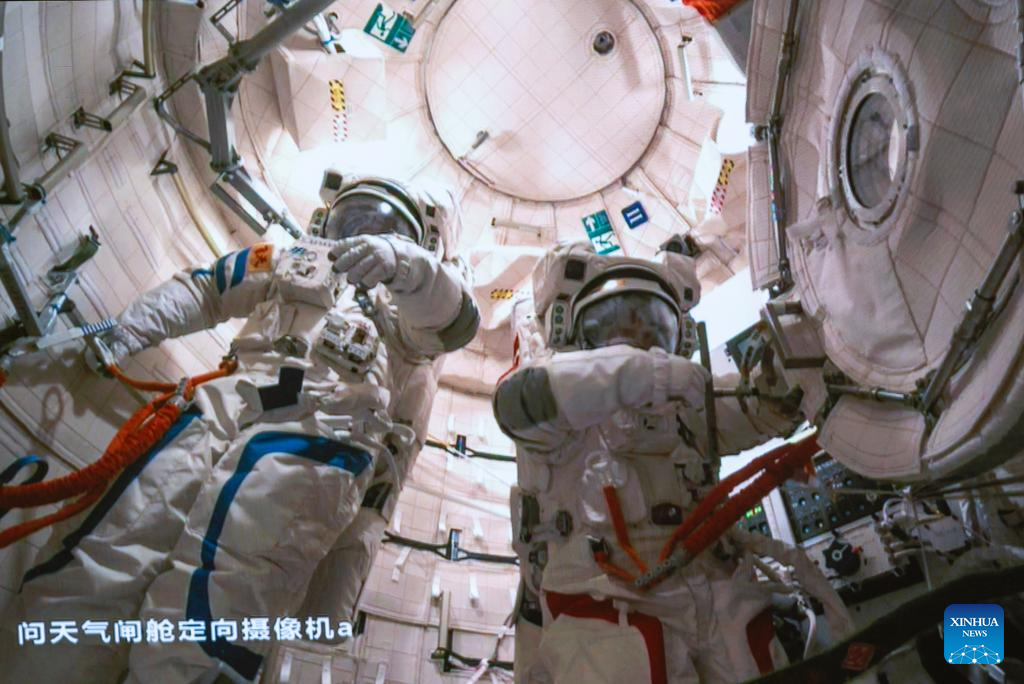
This screen image captured at Beijing Aerospace Control Center on March 21, 2025 shows Shenzhou-19 astronauts Cai Xuzhe (R) and Song Lingdong preparing for extravehicular activities inside the airlock cabin of China's orbiting space station. (Xinhua/Li Minggang)
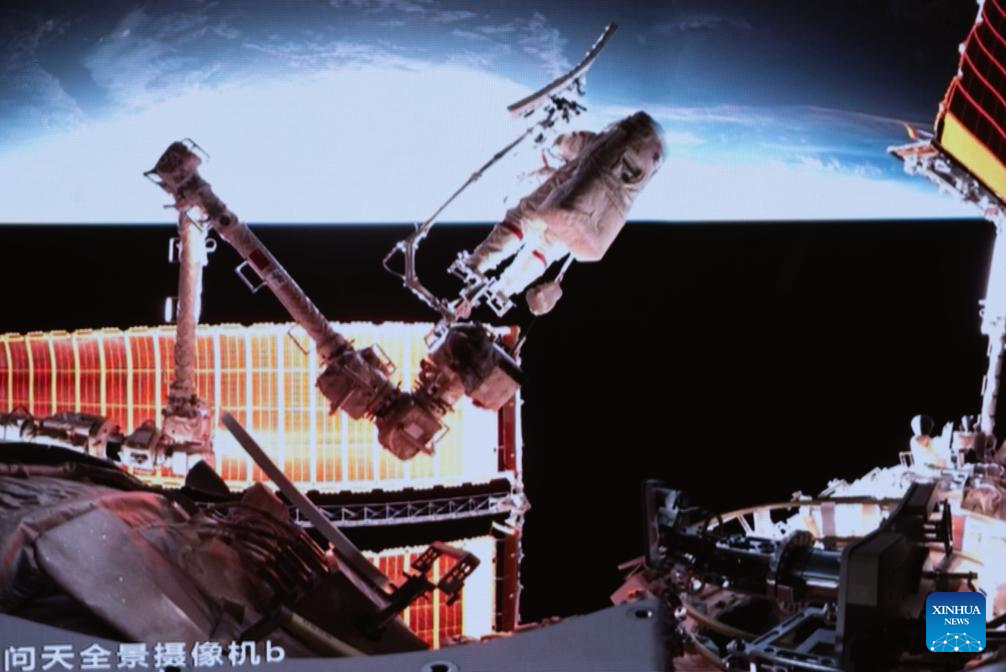
This screen image captured at Beijing Aerospace Control Center on March 21, 2025 shows Shenzhou-19 astronaut Cai Xuzhe performing extravehicular activities outside China's orbiting space station. (Xinhua/Li Minggang)
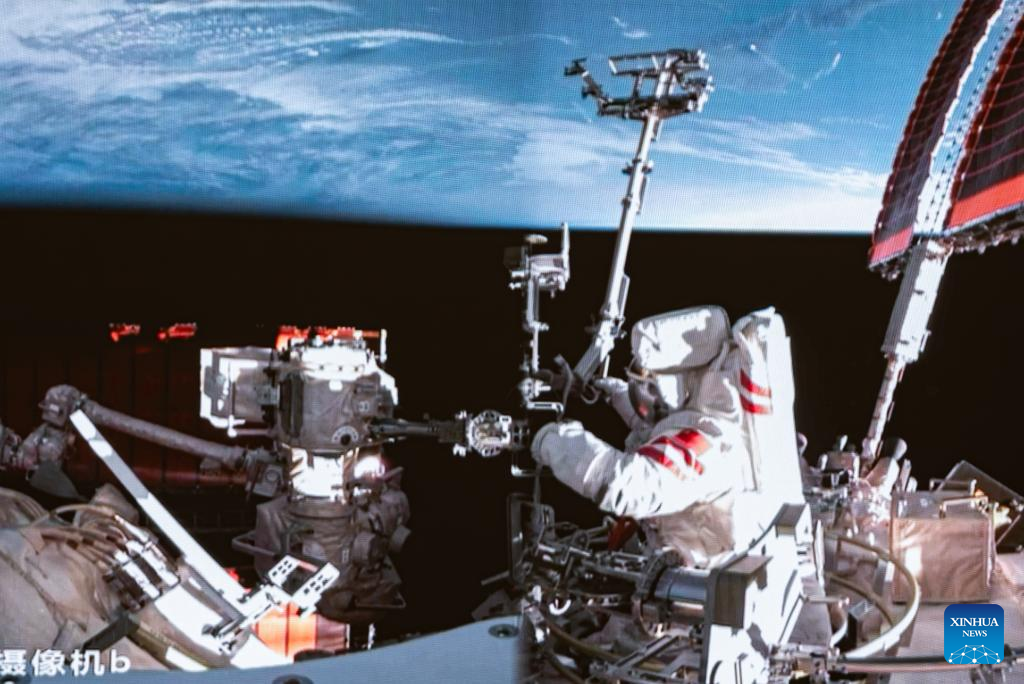
This screen image captured at Beijing Aerospace Control Center on March 21, 2025 shows Shenzhou-19 astronaut Cai Xuzhe performing extravehicular activities outside China's orbiting space station. (Xinhua/Li Minggang)
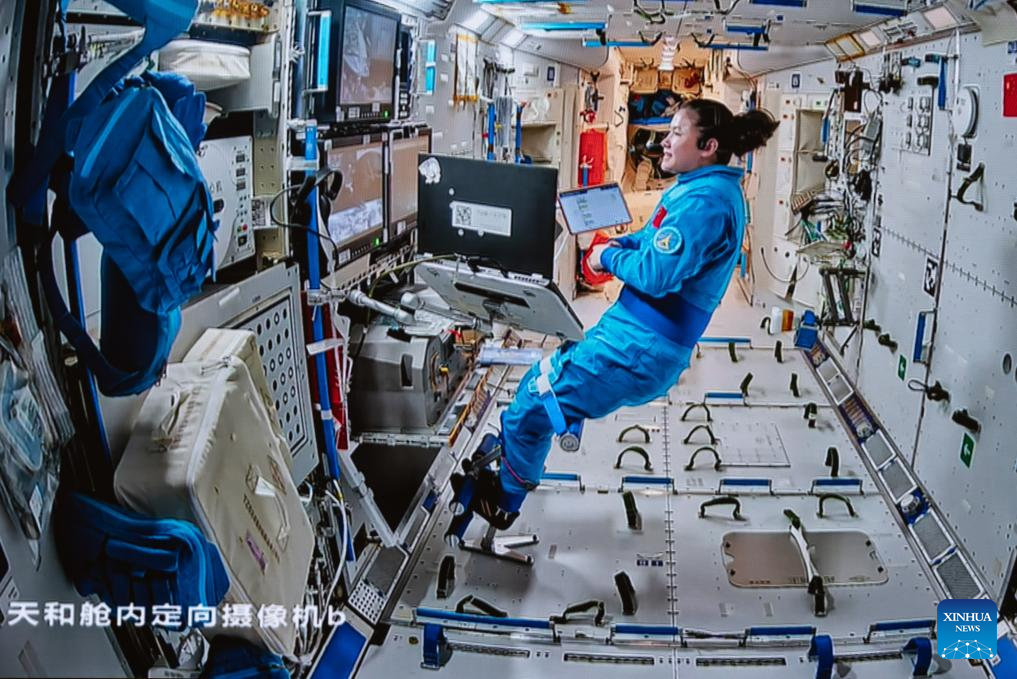
This screen image captured at Beijing Aerospace Control Center on March 21, 2025 shows Shenzhou-19 astronaut Wang Haoze working inside China's orbiting space station. (Xinhua/Li Minggang)
Quelle: Xinhua
----
Update: 11.05.2025
.
China to launch new modules to Tiangong space station
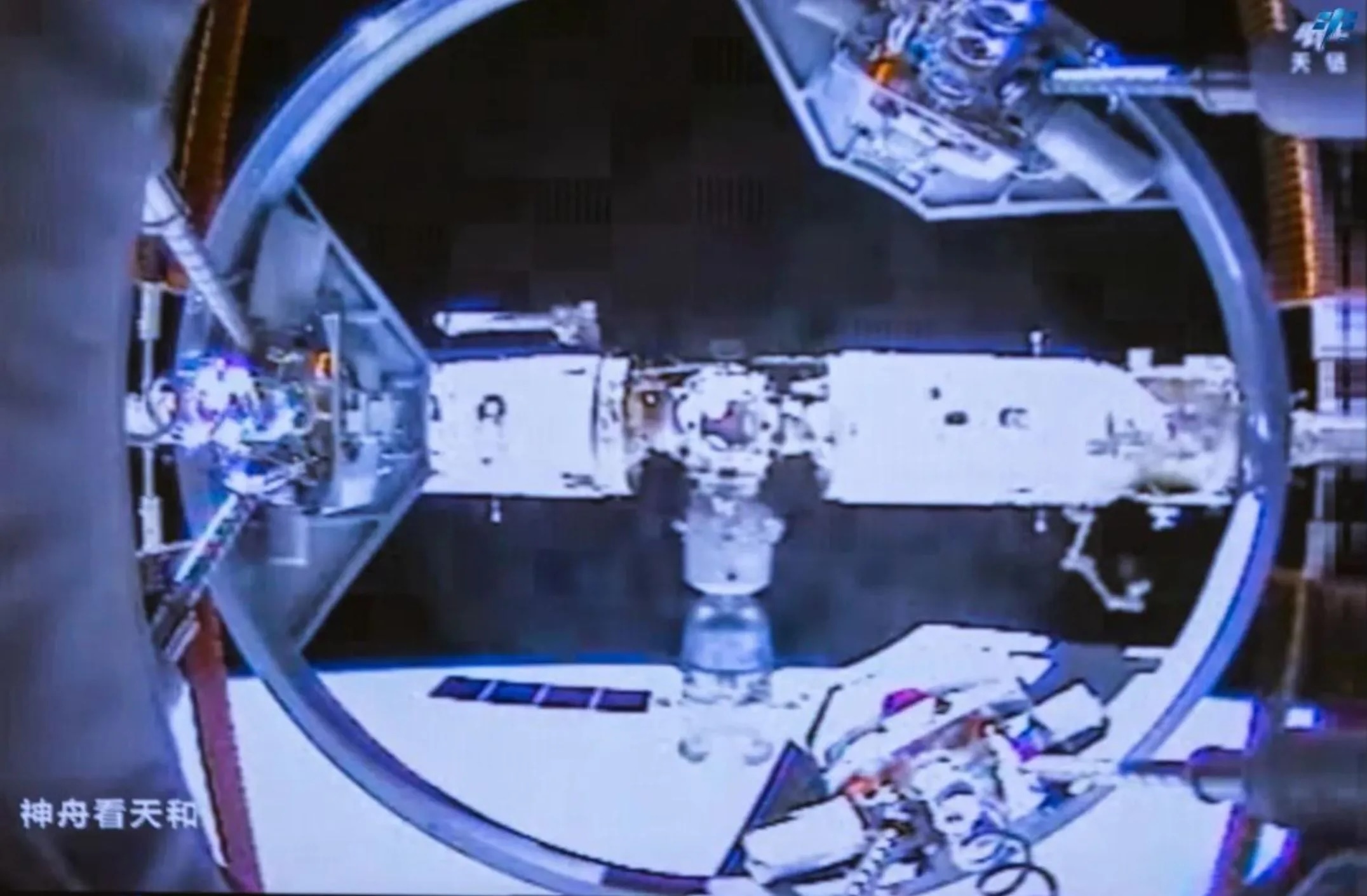
A view of Tiangong from the Shenzhou-17 spacecraft as it approaches the forward docking port. Credit: CMSEO
HELSINKI — China is preparing to launch new modules to its Tiangong space station to meet growing demands for science and potentially boost international cooperation.
The Long March 5B, currently China’s most powerful rocket, is slated to launch new Tiangong modules, according to an official with China’s state-owned main space contractor.
“According to the plan, the Long March 5B rocket will also carry out the future launches of additional modules for the crewed space station,” Wang Jue from China Aerospace Science and Technology Corporation (CASC) told China Central Television (CCTV) April 30.
No official timeline has been released for the missions, but the comments appear to confirm plans to add modules to Tiangong, a T-shaped, three-module orbital outpost constructed across 2021-2022.
China space officials have noted the possibility of expanding Tiangong on a number of occasions in recent years. The CCTV report, however, notes growing experimental demands which are placing higher requirements on the space station’s available space and energy supply.
Earlier reporting notes that a multi-functional expansion module could be the first new module to launch. It would feature six docking ports and dock with Tiangong’s core Tianhe module, allowing further modules to be integrated into the station.
Expanding Tiangong would enhance opportunities for science, payload hosting, and international cooperation, particularly for crewed missions.
Earlier this year, China’s human spaceflight agency also announced it would be training astronauts from Pakistan to fly to Tiangong, in what would be the first international astronauts to do so. An agency official also noted in April that it was in discussions with other countries regarding flights of their astronauts to Tiangong.
China is developing a new-generation crew spacecraft with two variants: one for low Earth orbit (LEO) and one, named Mengzhou, for crewed lunar missions. The partially reusable LEO version could carry as many as 6-7 astronauts to Tiangong, or fewer astronauts and up to 500 kilograms of cargo.
This would improve options and flexibility. Currently, China sends three astronauts to Tiangong aboard Shenzhou spacecraft for six-month-long missions. Flights involving international partners would likely be shorter in duration and involve fewer mission responsibilities, at least initially.
A first launch of the Long March 10 rocket for carrying the LEO new-gen spacecraft is scheduled for 2026. A common booster core variant is being developed for Mengzhou and the crewed lunar mission planned by China to launch before 2030.
The expected expansion signals China’s long-term commitment to maintaining a permanent human presence in low Earth orbit independent of the International Space Station, despite also working on crewed moon plans. A recent NASA budget proposal meanwhile looks to reduce funding for ISS operations, while commitment to backing commercial replacements is not clear.
Long March 5B safety
In the interview, Wang also noted efforts to improve safety, possibly referring to the uncontrolled reentries of the first stage of the Long March 5B launches used to construct Tiangong.
“The main focus will be on enhancing reliability and safety. On one hand, we aim to further improve the safety of controlled re-entry of the first-stage rocket body through optimized design. On the other hand, we will continue to increase the product’s maturity and stability in order to further enhance the inherent reliability of the Long March 5B in mission execution, laying a solid foundation for the continued construction of the space station.”
China has recently been using the Long March 5B to launch satellites for the Guowang megaconstellation. Those launches have used a Yuanzheng-2 upper stage to carry the payloads into orbit, with the first stage remaining suborbital and falling into the ocean in a planned manner.
Xuntian space telescope
The next Long March 5B launch for the Tiangong space station is likely to be the launch of the Xuntian space telescope—a 2.0-meter-aperture, “Hubble class” observatory with a field of view approximately 300 times greater than Hubble, allowing it to survey huge portions of the sky across a nominal 10-year mission.
Xuntian will feature a 2.5-gigapixel survey camera, and be used to study areas including dark matter, dark energy, galaxy formation and evolution of the cosmos. Xuntian will co-orbit with Tiangong, and be able to dock for maintenance, repairs, refueling and possibly upgrades.
Launch of Xuntian has been delayed by a number of years, but 2024 presentations indicate launch could take place in December 2026.
Quelle: SN
----
Update: 22.05.2025
.
Shenzhou-20 astronauts complete first spacewalk

This video screenshot taken at Beijing Aerospace Control Center on May 22, 2025 shows Shenzhou-20 astronaut Chen Dong leaving China's orbiting space station for extravehicular activities. The Shenzhou-20 crew on board China's orbiting space station completed their mission's first series of extravehicular activities on Thursday, according to the China Manned Space Agency. (Xinhua/Li Yanchen)
The Shenzhou-20 crew on board China's orbiting space station completed their mission's first series of extravehicular activities on Thursday, according to the China Manned Space Agency.
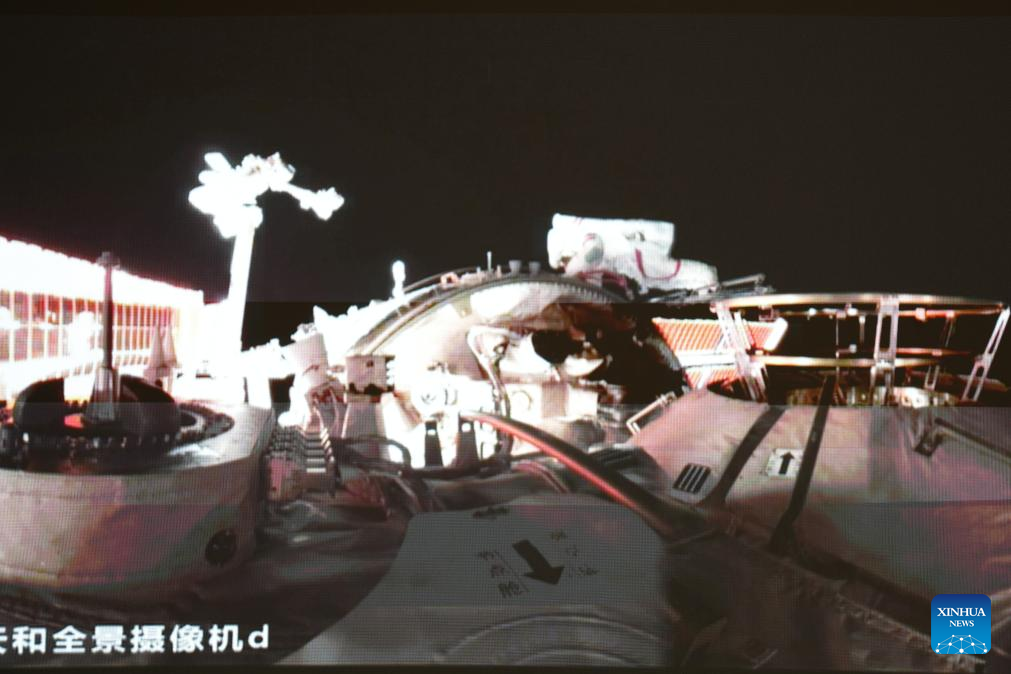
This screen image captured at Beijing Aerospace Control Center on May 22, 2025 shows Shenzhou-20 astronaut Chen Zhongrui performing extravehicular activities outside China's orbiting space station. The Shenzhou-20 crew on board China's orbiting space station completed their mission's first series of extravehicular activities on Thursday, according to the China Manned Space Agency. (Xinhua/Li Yanchen)
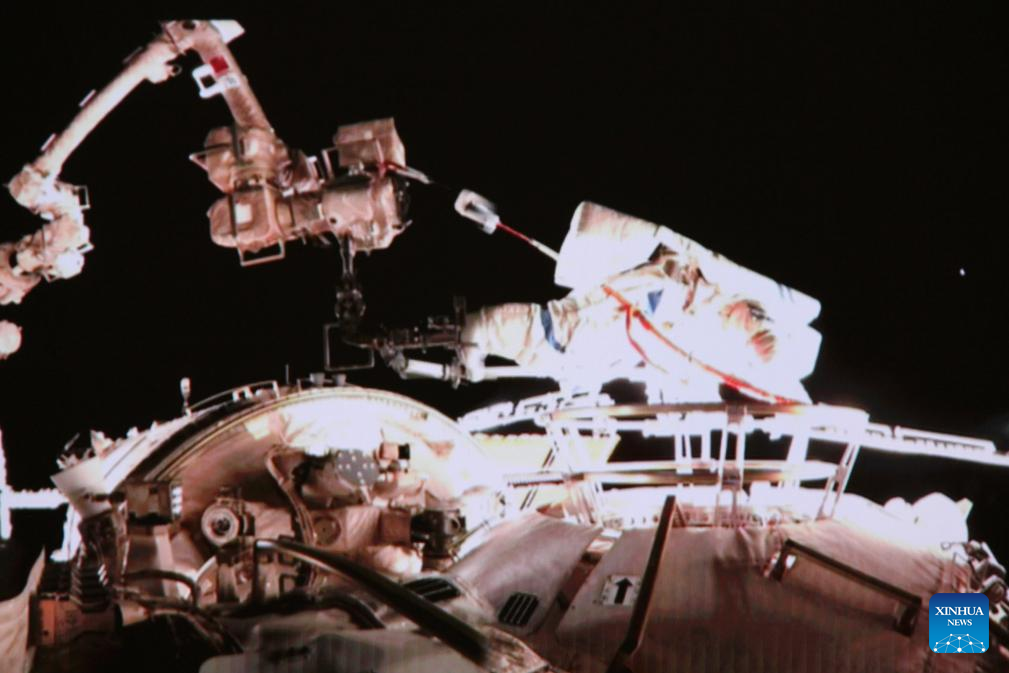
This screen image captured at Beijing Aerospace Control Center on May 22, 2025 shows Shenzhou-20 astronaut Chen Dong performing extravehicular activities outside China's orbiting space station. The Shenzhou-20 crew on board China's orbiting space station completed their mission's first series of extravehicular activities on Thursday, according to the China Manned Space Agency. (Xinhua/Li Yanchen)
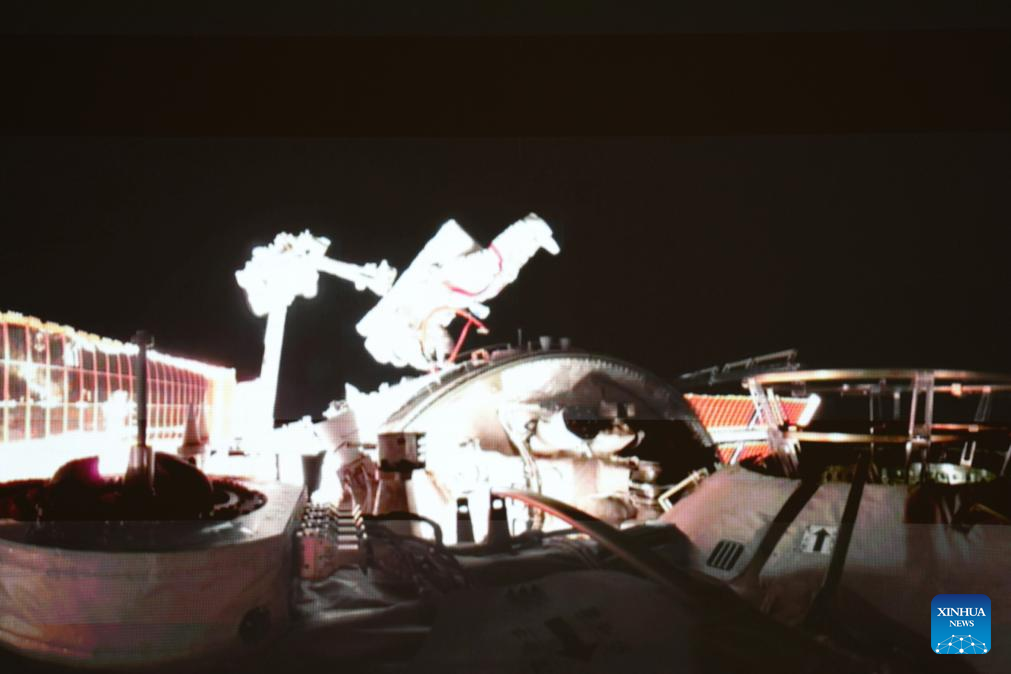
This screen image captured at Beijing Aerospace Control Center on May 22, 2025 shows Shenzhou-20 astronaut Chen Zhongrui performing extravehicular activities outside China's orbiting space station. The Shenzhou-20 crew on board China's orbiting space station completed their mission's first series of extravehicular activities on Thursday, according to the China Manned Space Agency. (Xinhua/Li Yanchen)

This screen image captured at Beijing Aerospace Control Center on May 22, 2025 shows Shenzhou-20 astronaut Chen Dong performing extravehicular activities outside China's orbiting space station. The Shenzhou-20 crew on board China's orbiting space station completed their mission's first series of extravehicular activities on Thursday, according to the China Manned Space Agency. (Xinhua/Li Yanchen)
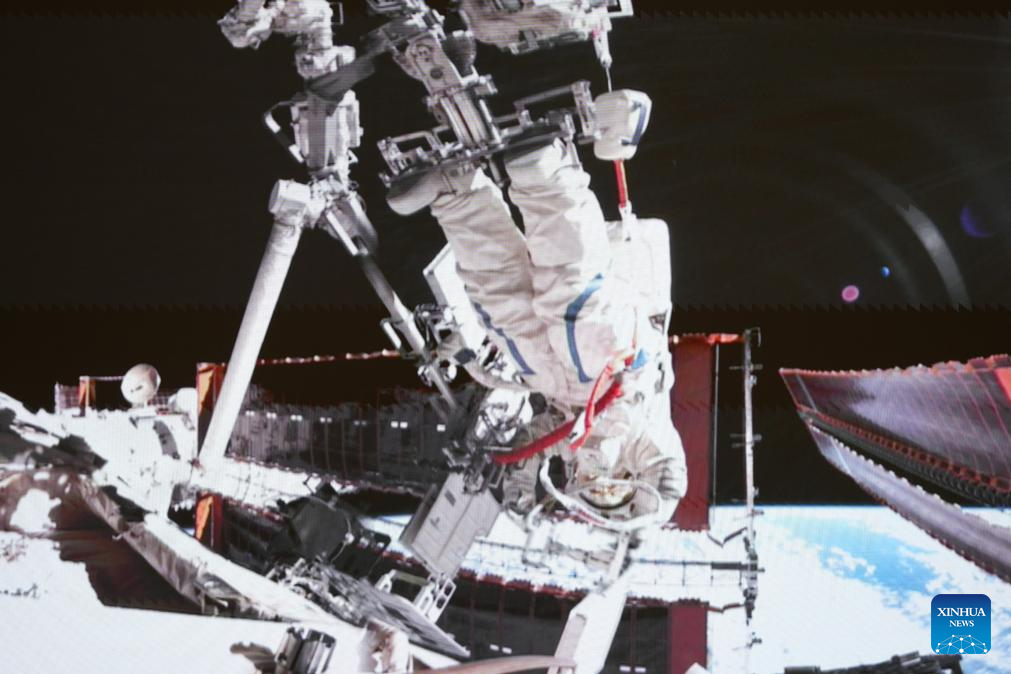
This screen image captured at Beijing Aerospace Control Center on May 22, 2025 shows Shenzhou-20 astronaut Chen Dong performing extravehicular activities outside China's orbiting space station. The Shenzhou-20 crew on board China's orbiting space station completed their mission's first series of extravehicular activities on Thursday, according to the China Manned Space Agency. (Xinhua/Li Yanchen)

This screen image captured at Beijing Aerospace Control Center on May 22, 2025 shows Shenzhou-20 astronaut Chen Dong performing extravehicular activities outside China's orbiting space station. The Shenzhou-20 crew on board China's orbiting space station completed their mission's first series of extravehicular activities on Thursday, according to the China Manned Space Agency. (Xinhua/Li Yanchen)
Quelle: Xinhua
----
Update: 18.06.2025
.
China Focus: What the Shenzhou-20 astronauts are doing after over 50 days in space
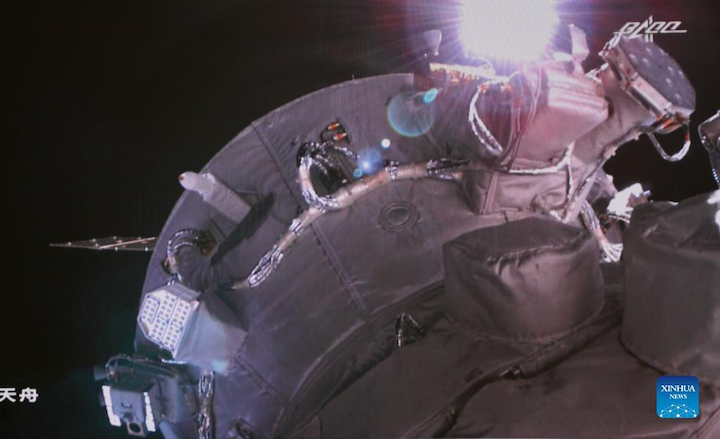
Imagine living and working hundreds of miles above Earth for over 50 days. This sci-fi scene has been a reality for China's Shenzhou-20 crew -- Chen Dong, Chen Zhongrui, and Wang Jie -- aboard the Tiangong Space Station.
Far from a quiet getaway, a short video released by China's state television broadcaster CCTV on Monday showed their "space business trip," which is packed with vital scientific work, health checks, and station upkeep, all of which are crucial for future space exploration.
The astronaut trio are in good condition and the multi-disciplinary space science experiments are advancing smoothly, according to the CCTV report.
The crew, commanded by veteran astronaut Chen Dong, was launched into orbit on April 24 for a six-month mission.
Over the past week, they devoted substantial time to space medicine research. During their research, they have explored fundamental aspects of cognitive function in microgravity, focusing on teamwork dynamics, self-awareness in isolation and how astronauts perceive motion, depth, and relationships absent Earth's gravity. These studies are critical for ensuring safe operations during spacewalks and complex tasks.
In addition, they also conducted routine vascular ultrasound scans tracked changes in cardiovascular function over time and used apparatus to capture subtle changes in control and coordination during precise tasks like equipment operation or sample handling, according to the report.
On the front of life science, they focused on the "effects and mechanisms of space microgravity on microorganisms" experiment.
The video showed that in Tiangong's specialized biotechnology experiment rack, the crew observed the growth, developmental patterns, and bioactive compound synthesis of Streptomyces bacteria in weightlessness.
This research is expected to reveal new biological adaptations and potential applications for space-based pharmaceutical research.
The crew carefully sampled liquid cultures, preserving the samples for their eventual journey back to Earth.
Another highlight of their daily routine, in addition to the meticulous space station upkeep, is their rigorous exercise to counter the physical toll of microgravity. The video captures the astronauts running on a treadmill in the space module.
Beyond exercise, the crew undergoes regular checkups like detailed heart monitoring and blood pressure tracking. They also participate in unique health assessments based on traditional Chinese medicine principles, according to the report.
China's space station has now hosted over 200 scientific projects, with nearly 2 tonnes of scientific materials and applied equipment sent to orbit and nearly 100 experimental samples returned to Earth, according to the China Manned Space Agency.
Quelle: Xinhua
----
Update: 28.06.2025
.
China’s Shenzhou-20 astronauts complete second spacewalk to enhance Tiangong space station
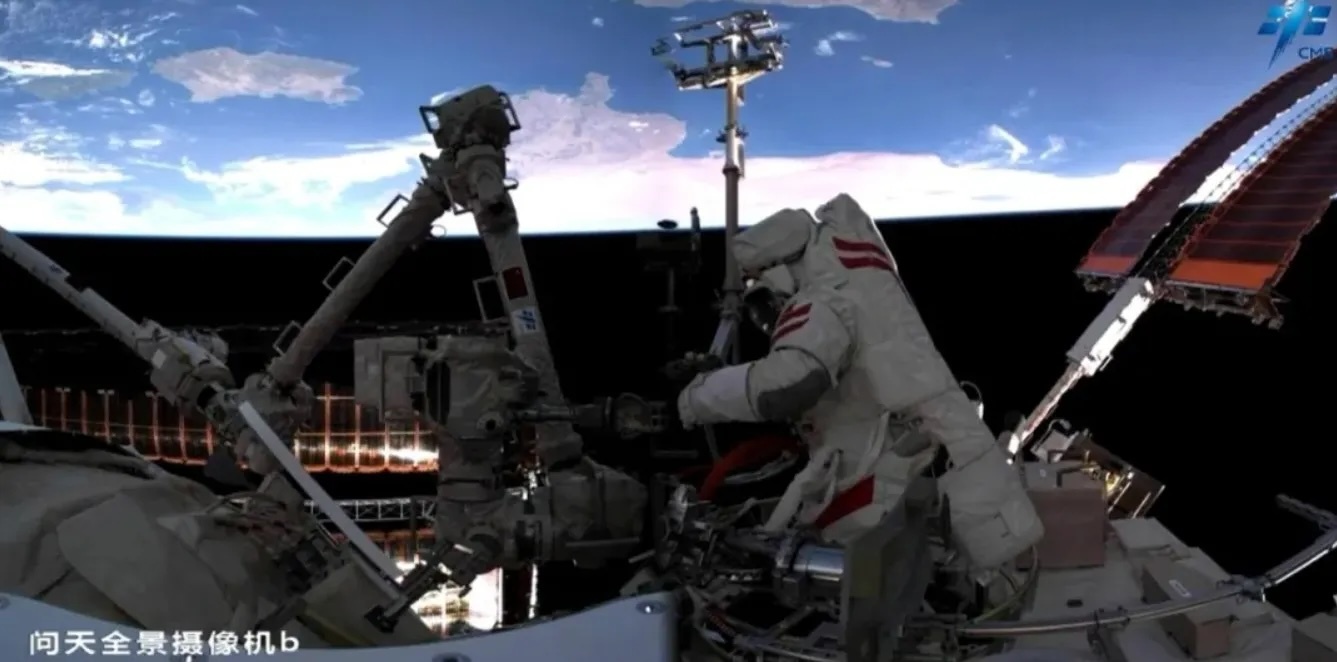
Astronaut Chen Zhongrui working outside Tiangong during a spacewalk on June 26, 2025. Credit: CMSEO
HELSINKI — Two Chinese astronauts conducted an extravehicular activity outside the Tiangong space station Thursday, marking their second spacewalk in five weeks.
Astronaut Chen Zhongrui opened the Wentian module hatch at 3:04 a.m. Eastern (0704 UTC) June 26, beginning activities, ascending to the tip of Tiangong’s robotic arm. Mission commander Chen Dong, wearing a Feitian EVA suit with blue stripes, joined his colleague two hours later. Wang Jie, formerly an engineer with the China Aerospace Science and Technology Corporation (CASC), assisted operations from within Tiangong.
During the EVA, Chen Dong and Chen Zhongrui, a former air force pilot on his first visit to orbit, installed debris protective shielding outside of Tiangong, while also inspecting and installing extravehicular equipment and interfaces out the space station. Newly installed automated foot restraint adapters and interface adapters on Tiangong’s robotic arm platform used for spacewalks mean that subsequent EVAs are expected to be shortened by approximately 40 minutes, according to CMSEO.
“In the previous spacewalks, astronauts had to install foot limiter and operation platform on the robotic arm’s end effector before and after exiting the module, and then rely on the arm to transport them to the work site,” Li Xuedong, lead designer of the space station system at the CASC, told CCTV.
The pair completed the almost 6.5-hour spacewalk at 9:29 a.m. Eastern (1329 UTC), the China Manned Space Engineering Office (CMSEO) announced in a statement. CMSEO had stated a day earlier that the extravehicular activity (EVA) would take place “in the near future.”
This was the crew’s second EVA, following a first spacewalk May 22. During that EVA, Chen Dong and Chen Zhongrui exited Tiangong through the Tianhe core module EVA hatch. The eight-hour spacewalk was completed at 4:49 a.m. (0849 UTC) and also involved the installation of debris protective shielding.
The six-month-long Shenzhou-20 mission began April 24, with launch on a hypergolic propellant Long March 2F rocket from Jiuquan spaceport in northwest China, seeing the spacecraft dock at Tiangong around 6.5 hours later.
CMSEO stated that the crew have made steady progress in conducting planned experiments in fields including space life sciences and human research, microgravity physics and new space technology.
Previous video reports on the mission from the agency note that the crew have utilized a Raman spectrometer to conduct experiments on microbiota and nutrition metabolism, including assessing metabolic components in urine samples for investigating the interactive regulation of bone metabolism and other studies.
As well as completing maintenance duties related to resistance exercise equipment, the station’s regenerative life support system and thermal control equipment, the trio have also been interacting with an “intelligent” spaceflight robot named “Xiao Hang” to explore efficient collaboration methods between humans and robots.
Other experiments include assessing the impacts of microgravity on microorganisms, using streptomyces bacteria hosted in the biotechnology experiment cabinet. Liquid culture samples were frozen and stored in preparation for further study back on Earth.
In early June, Chen, Chen and Wang also interacted with 300 Hungarian students, scientists, and government officials in Budapest, answering questions submitted in advance. The “Tiangong Classroom,” event was co-hosted by CMSEO, the Chinese Embassy in Hungary and the Hungarian Academy of Sciences. The international event suggests an expansion of soft power outreach and diplomacy efforts using China’s human spaceflight activities, whereas most Tiangong classrooms have engaged with Chinese students.
The Shenzhou-20 mission is Chen Dong’s third spaceflight and his second command, after leading the 2022 Shenzhou-14 mission which oversaw the arrival of Tiangong’s two experiment modules, Wentian and Mengtian.
Back on Earth, teams are preparing for the launch of the Tianzhou-9 cargo supply spacecraft to Tiangong. Launch via a Long March 7 rocket from the coastal Wenchang spaceport is expected no earlier than July 14. Tiangong released an object into orbit early April, cataloged with the international designator 2021-035E, that may have been a cubesat delivered by the Tianzhou-8 resupply spacecraft currently docked at the station.
On June 17, China conducted a pad abort test for its new-generation Mengzhou spacecraft. The low Earth orbit variant of Mengzhou will be able to carry 6-7 astronauts to Tiangong, launching on a new Long March 10A rocket currently in development. While the space station currently hosts crews of three for six-month-long rotations, China is planning to expand the three-module orbital outpost with further modules in the coming years.
Quelle: SN
+++
Shenzhou-20 astronauts complete second series of extravehicular activities
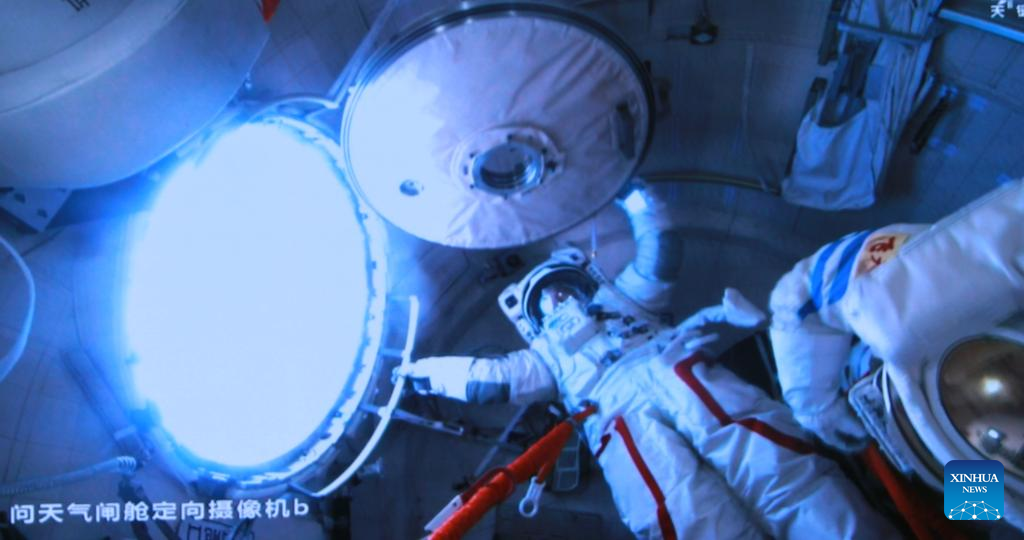
This screen image captured at Beijing Aerospace Control Center on June 26, 2025 shows Shenzhou-20 astronauts Chen Dong (R) and Chen Zhongrui closing the hatch of space station lab module Wentian's airlock cabin. (Photo by Zhou Keyi/Xinhua)
The Shenzhou-20 crew on board China's orbiting space station completed their mission's second series of extravehicular activities on Thursday, according to the China Manned Space Agency (CMSA).
The astronaut trio -- Chen Dong, Chen Zhongrui and Wang Jie -- worked for about 6.5 hours and completed the task at 9:29 p.m. (Beijing Time), assisted by the space station's robotic arm and a team on Earth.
Chen Dong and Chen Zhongrui, tasked with conducting spacewalk operations, completed the installation of a debris protection device and the inspection and maintenance of external equipment, according to the CMSA.
They also installed foot restraint adapters and interface adapters on the extravehicular platform, which will help astronauts during extravehicular activities. Subsequent spacewalks are expected to be shortened by approximately 40 minutes as a result, the CMSA said.
The crew is currently making steady progress on various space science experiments. Next, they will focus on conducting research and technology tests in key areas such as space life sciences, microgravity fundamental physics, space materials science, space medicine, and advanced aerospace technologies. ■

This screen image captured at Beijing Aerospace Control Center on June 26, 2025 shows Shenzhou-20 astronaut Chen Zhongrui performing extravehicular activities outside China's orbiting space station. (Photo by Zhou Keyi/Xinhua)

This screen image captured at Beijing Aerospace Control Center on June 26, 2025 shows Shenzhou-20 astronauts Chen Dong (R) and Chen Zhongrui closing the hatch of space station lab module Wentian's airlock cabin. (Photo by Zhou Keyi/Xinhua)

This screen image captured at Beijing Aerospace Control Center on June 26, 2025 shows Shenzhou-20 astronaut Chen Zhongrui performing extravehicular activities outside China's orbiting space station. (Photo by Zhou Keyi/Xinhua)

This screen image captured at Beijing Aerospace Control Center on June 26, 2025 shows Shenzhou-20 astronauts Chen Dong (L) and Chen Zhongrui performing extravehicular activities outside China's orbiting space station. (Photo by Zhou Keyi/Xinhua)

This screen image captured at Beijing Aerospace Control Center on June 26, 2025 shows Shenzhou-20 astronauts Chen Dong (L) and Chen Zhongrui performing extravehicular activities outside China's orbiting space station. (Photo by Zhou Keyi/Xinhua)

This screen image captured at Beijing Aerospace Control Center on June 26, 2025 shows Shenzhou-20 astronauts Chen Dong (L) and Chen Zhongrui performing extravehicular activities outside China's orbiting space station. (Photo by Zhou Keyi/Xinhua)
Quelle: Xinhua
----
Update: 9.07.2025
.
China's Tianzhou-8 cargo craft separates from space station combination
The Tianzhou-8 cargo craft, tasked with carrying supplies for China's space station, separated from the station combination at 3:09 p.m. Tuesday (Beijing Time) and switched to independent flight, according to the China Manned Space Agency (CMSA).
The cargo craft will re-enter the Earth's atmosphere in a controlled manner. Most of its components will burn up and be destroyed during the process, while a small amount of debris will fall into designated safe waters, the CMSA said.
Tianzhou-8 was launched on Nov. 15, 2024 from the Wenchang Spacecraft Launch Site in the southern island province of Hainan, and then docked with the orbiting Tiangong space station on Nov. 16.
Quelle: Xinhua
